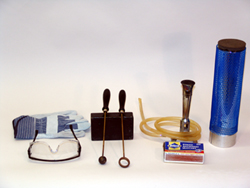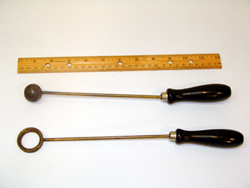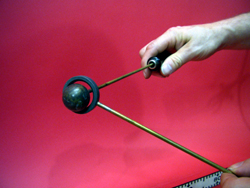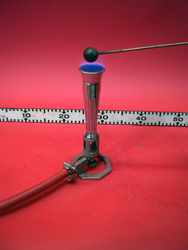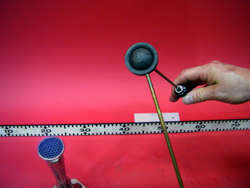Ball and Ring, 4A30.21
Topic and Concept:
Thermal Properties of Matter, 4A30. Solid Expansion
Location:
Cabinet: Thermodynamics Cabinet
Bay: (A3)
Shelf: #1
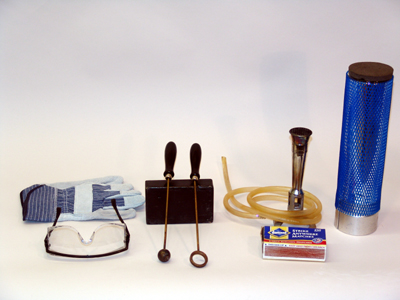
Description:
Two sets of a brass ring and a brass ball.
Equipment |
Location |
ID Number |
|
|
|
Two sets of a ring and a ball |
4A30.21 |
|
Burner |
location |
NA |
Liquid nitrogen |
location |
NA |
Safety glove and glasses |
location |
NA |
Rooms 2103, 2241, (and 2223 upon request) |
|
Important Setup Notes:
This demonstration requires a supply of methane gas usually provided by the red and white gas carts found in rooms 2103, 2241, (and 2223 upon request).
- This demonstration requires a supply of liquid nitrogen. The main supply is located at the loading dock. If 12 hours notice given to lecture demo, supply will be provided.
Setup and Procedure:
To light the burner, connect the attached gas hose to the gas out (red panel) on the red and white gas cart.
- Open the gas valve.
- Light a match and bring it near the top of the burner.
- The flame will ignite the gas. Adjust the flame height accordingly by adjusting the valve.
Option A. Shrinking and expanding the ball
- Show that the ball can get through the hole.
- Heat the ball with the burner and show that the ball can no longer fit through the ring.
- Soak the ball in the liquid nitrogen and show that it can fit through the ring again.
Option B. Shrinking and expanding the ring
- Show that the ball can get through the hole.
- Soak the ring in the liquid nitrogen and show that the ball can no longer fit through the ring.
- Heat the ring with the burner and show that the ball can fit through the ring again.
Cautions, Warnings, or Safety Concerns:
- Always use the gloves and safety glasses throughout this demonstration.
- Beware of the heated plate - contact with skin could cause severe burns!
- Use care when working with the liquid nitrogen - prolonged contact with skin causes severe frostbite!
Discussion:
When the ring or ball is heated, the dimensions of the ring or ball increase while maintaining their relative proportions. Heating causes the molecular bonds to lengthen, which causes the materials to expand. For the ring, you can think about it this way: a group of people standing in a tight circle with elbows linked try to lengthen their "bonds" by moving to hold hands at arms length. They have to expand the circle by standing back everyone stands further apart. This is analogous to the molecular bonds in the ring. This is considered a 2D expansion (the ring thickness is quite thin relative to the other dimensions) and can be described by
ΔA/A = αA*ΔT = αL2*ΔT
where A is the area at temperature Ti, ΔA is the change in area when the material is at temperature Tf, ΔT is Tf - Ti, and α is the coefficient of thermal expansion which depends on the material. The expansion of the ball is also 2D since the quantity of importance is the cross sectional area. See references below for more information.
|
|
|
|
|
|
|
|
References:
